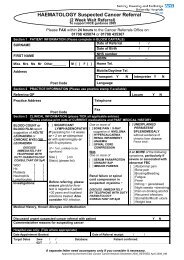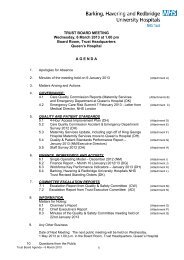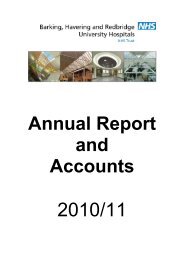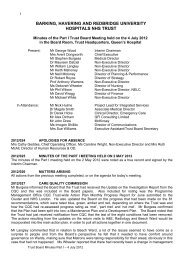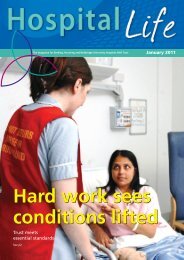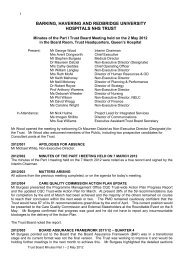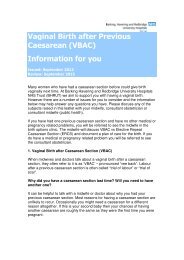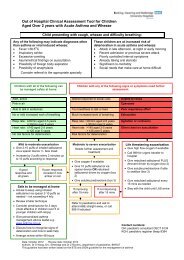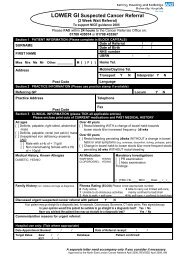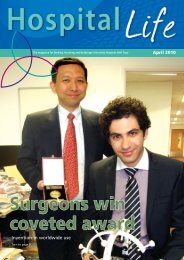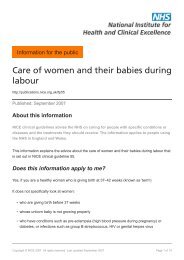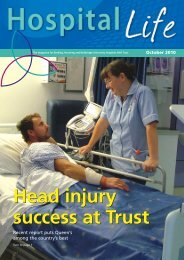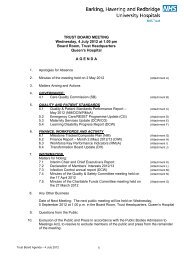BHRUT annual report 2009 - Barking Havering and Redbridge ...
BHRUT annual report 2009 - Barking Havering and Redbridge ...
BHRUT annual report 2009 - Barking Havering and Redbridge ...
You also want an ePaper? Increase the reach of your titles
YUMPU automatically turns print PDFs into web optimized ePapers that Google loves.
42<br />
<strong>Barking</strong>, <strong>Havering</strong> & <strong>Redbridge</strong> University Hospitals NHS Trust<br />
1.6 Revenue<br />
Revenue in respect of services provided is recognised<br />
when, <strong>and</strong> to the extent that, performance occurs,<br />
<strong>and</strong> is measured at the fair value of the consideration<br />
receivable. The main source of revenue for the trust is<br />
from commissioners for healthcare services. Revenue<br />
relating to patient care spells that are part-completed<br />
at the year end are apportioned across the financial<br />
years on the basis of length of stay at the end of the<br />
<strong>report</strong>ing period compared to expected total length of<br />
stay/costs incurred to date compared to total expected<br />
costs.<br />
Where income is received for a specific activity that is<br />
to be delivered in the following year, that income is<br />
deferred.<br />
The Trust receives income under the NHS Injury Cost<br />
Recovery Scheme, designed to reclaim the cost of<br />
treating injured individuals to whom personal injury<br />
compensation has subsequently been paid e.g. by an<br />
insurer. The Trust recognises the income when it<br />
receives notification from the Department of Work<br />
<strong>and</strong> Pension's Compensation Recovery Unit that the<br />
individual has lodged a compensation claim. The<br />
income is measured at the agreed tariff for the<br />
treatments provided to the injured individual, less a<br />
provision for unsuccessful compensation claims <strong>and</strong><br />
doubtful debts.<br />
1.7 Employee Benefits<br />
Short-term employee benefits<br />
Salaries, wages <strong>and</strong> employment-related payments are<br />
recognised in the period in which the service is<br />
received from employees.<br />
The cost of leave earned but not taken by employees<br />
at the end of the period is recognised in the financial<br />
statements to the extent that employees are permitted<br />
to carry forward leave into the following period.<br />
Retirement benefit costs<br />
Past <strong>and</strong> present employees are covered by the<br />
provisions of the NHS Pensions Scheme. The scheme<br />
is an unfunded, defined benefit scheme that covers<br />
NHS employers, General Practices <strong>and</strong> other bodies,<br />
allowed under the direction of the Secretary of State,<br />
in Engl<strong>and</strong> <strong>and</strong> Wales. The scheme is not designed to<br />
be run in a way that would enable NHS bodies to<br />
identify their share of the underlying scheme assets<br />
<strong>and</strong> liabilities. Therefore, the scheme is accounted for<br />
as if it were a defined contribution scheme: the cost<br />
to the NHS body of participating in the scheme is<br />
taken as equal to the contributions payable to the<br />
scheme for the accounting period.<br />
For early retirements other than those due to ill health<br />
the additional pension liabilities are not funded by the<br />
scheme. The full amount of the liability for the<br />
additional costs is charged to expenditure at the time<br />
the Trust commits itself to the retirement, regardless of<br />
the method of payment.<br />
Some employees are members of the Local<br />
Government Superannuation Scheme, which is a<br />
defined benefit pension scheme. The scheme assets<br />
<strong>and</strong> liabilities attributable to those employees can be<br />
identified <strong>and</strong> are recognised in the trust’s accounts.<br />
The assets are measured at fair value <strong>and</strong> the liabilities<br />
at the present value of the future obligations. The<br />
increase in the liability arising from pensionable service<br />
earned during the year is recognised within operating<br />
expenses. The expected gain during the year from<br />
scheme assets is recognised within finance income.<br />
The interest cost during the year arising from the<br />
unwinding of the discount on the scheme liabilities is<br />
recognised within finance costs. Actuarial gains <strong>and</strong><br />
losses during the year are recognised in the pensions<br />
reserve <strong>and</strong> <strong>report</strong>ed as an item of other<br />
comprehensive income.<br />
1.8 Other expenses<br />
Other operating expenses are recognised when, <strong>and</strong><br />
to the extent that, the goods or services have been<br />
received. They are measured at the fair value of the<br />
consideration payable.<br />
Annual Accounts



![[4] Biopsy Leaflet.pub - Barking, Havering and Redbridge University ...](https://img.yumpu.com/51285530/1/190x134/4-biopsy-leafletpub-barking-havering-and-redbridge-university-.jpg?quality=85)

